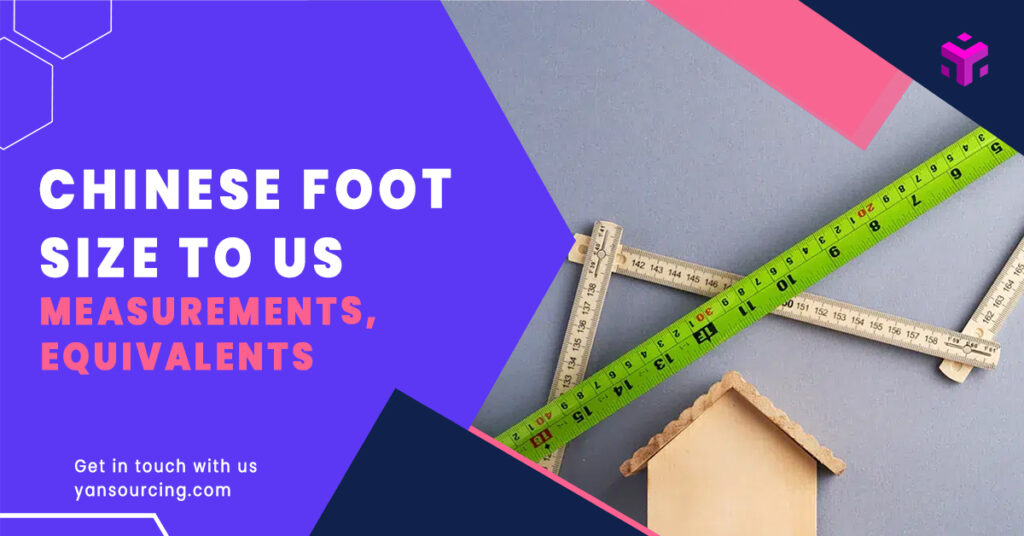
Shopping for shoes online can be tricky. Converting Chinese foot size to US sizes is often confusing. A small size mistake can ruin your perfect shoes. A study of 1 million foot scans showed significant size differences. These differences depend on region and gender. The study suggests that shoes should have three width choices per size. This approach helps more people find a good fit. Without correct size conversions, finding the right size becomes challenging. Knowing these measurements, including how to convert Chinese foot size to US, helps ensure your shoes fit well. It also saves you time and stress.
Key Takeaways
Chinese shoe sizes are based on foot length in centimeters, making them straightforward to measure.
Use a ruler to measure your feet accurately. This helps you choose the right size from a Chinese shoe chart.
US shoe sizes include half-sizes and widths, which can complicate size conversions.
Always check brand-specific size guides when shopping for shoes. Sizes can vary between brands.
If your size falls between two options, choose the larger size for comfort, especially for everyday wear.
Measure your feet in the evening when they are slightly swollen for the best fit.
Read customer reviews to gain insights on how shoes fit. This can help you avoid size mistakes.
Using reliable size conversion charts can save you time and reduce the hassle of returns.
Key Differences Between Chinese and US Shoe Sizing Systems
How Chinese Shoe Sizes Are Measured
Chinese shoe sizes use your foot length in centimeters. This simple method helps you measure and pick the right size. The US system uses numbers, but the Chinese system focuses on exact measurements. For example, a 22.0 cm foot equals a Chinese size 35. A 27.0 cm foot matches size 44.
Here’s a quick chart to compare Chinese and US sizes:
US Size | |
|---|---|
22.0 | 5 |
22.5 | 5.5 |
23.0 | 6 |
23.5 | 6.5 |
24.0 | 7 |
24.5 | 7.5 |
25.0 | 8 |
25.5 | 8.5 |
26.0 | 9 |
26.5 | 9.5 |
27.0 | 10 |
Chinese sizes grow by 5mm per size, making them consistent. This is helpful when shopping online for Chinese shoes.
Tip: Use a ruler to measure your feet in centimeters. This ensures you pick the correct size from a Chinese shoe chart.
Understanding US Shoe Sizing Standards
The US system is more detailed. It uses numbers and half-sizes, which grow by about 4.23mm. This is slightly smaller than the 5mm steps in Chinese sizes.
US shoes also come in different widths. These include narrow (AA), medium (B), and wide (D). This helps fit various foot shapes but makes size conversions harder.
A study of over 1 million foot scans showed big differences in foot sizes. These differences depend on regions like Asia, Europe, and North America. This proves why size charts are important for finding the right fit.
Comparing Chinese Foot Size to US Measurements
Units of measurement: centimeters vs. inches
Chinese sizes use centimeters, but US sizes use inches. This makes converting tricky. One centimeter equals 0.3937 inches. Even small rounding mistakes can cause wrong sizes.
Gender-specific sizing differences
Chinese sizes are unisex, but US sizes are split by gender. For example:
Men’s Chinese sizes range from 39 to 46, or US sizes 6.5 to 12.
Women’s Chinese sizes range from 35 to 41, or US sizes 5 to 9.5.
Gender | Chinese Size Range | Approximate US Equivalent |
|---|---|---|
Men | 39-46 | 6.5-12 |
Women | 35-41 | 5-9.5 |
Variations in sizing for children and adults
Kids’ shoe sizes differ a lot between the two systems. Chinese kids’ sizes use centimeters, but the US has separate scales for toddlers, kids, and youth. This makes converting sizes harder.
When buying kids’ shoes, always check a detailed Chinese size chart for accuracy.

Note: Wearing the right shoe size keeps your feet healthy and comfy. Shoes that don’t fit can cause blisters and other problems, especially when shopping online.
Chinese Shoe Size Chart and Conversion Guide
Chinese to US Shoe Size Conversion for Men
Finding the right shoe size can feel like solving a puzzle, especially when you’re shopping for men’s shoes. Chinese sizes rely on foot length in centimeters, while US sizes use a numerical system. To make things easier, here’s a size conversion table for men’s shoes:
Chinese Size (cm) | US Size |
|---|---|
24.0 | 6 |
24.5 | 6.5 |
25.0 | 7 |
25.5 | 7.5 |
26.0 | 8 |
26.5 | 8.5 |
27.0 | 9 |
27.5 | 9.5 |
28.0 | 10 |
28.5 | 10.5 |
29.0 | 11 |
29.5 | 11.5 |
30.0 | 12 |
This size conversion table ensures you can match your foot length to the correct US size. For instance, if your foot measures 27.0 cm, you’ll need a US size 9.
Tip: Always measure your feet in the evening when they’re slightly swollen. This helps you avoid buying shoes that feel tight later.
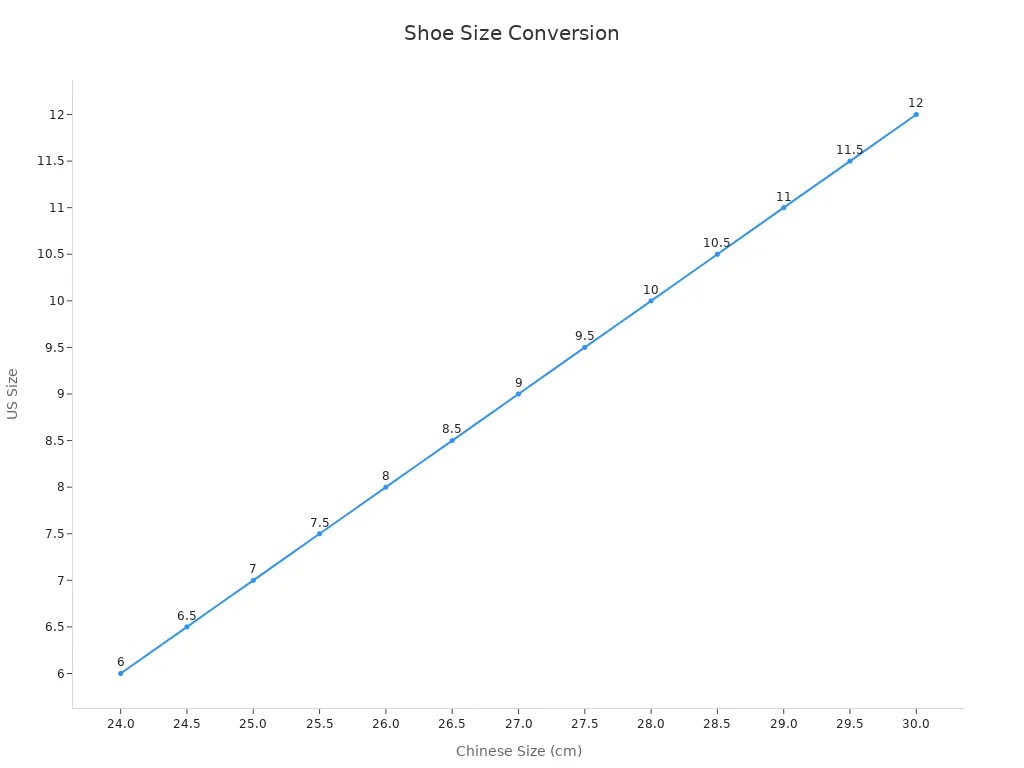
Chinese to US Shoe Size Conversion for Women
Women’s shoe sizes also vary between the two systems. Chinese sizes are straightforward, but US sizes include half-sizes for a more precise fit. Here’s a handy size conversion table for women:
US Women Size | China Women Size |
|---|---|
5 | 35 |
6 | 36 |
7 | 37 |
8 | 38 |
9 | 39 |
10 | 40 |
11 | 41 |
12 | 42 |
13 | 43 |
For example, if you wear a US size 8, you’ll need a Chinese size 38. This table simplifies the process, so you don’t have to guess.
Note: Some brands may have slight variations in their sizing. Always check the brand’s specific size guide before making a purchase.
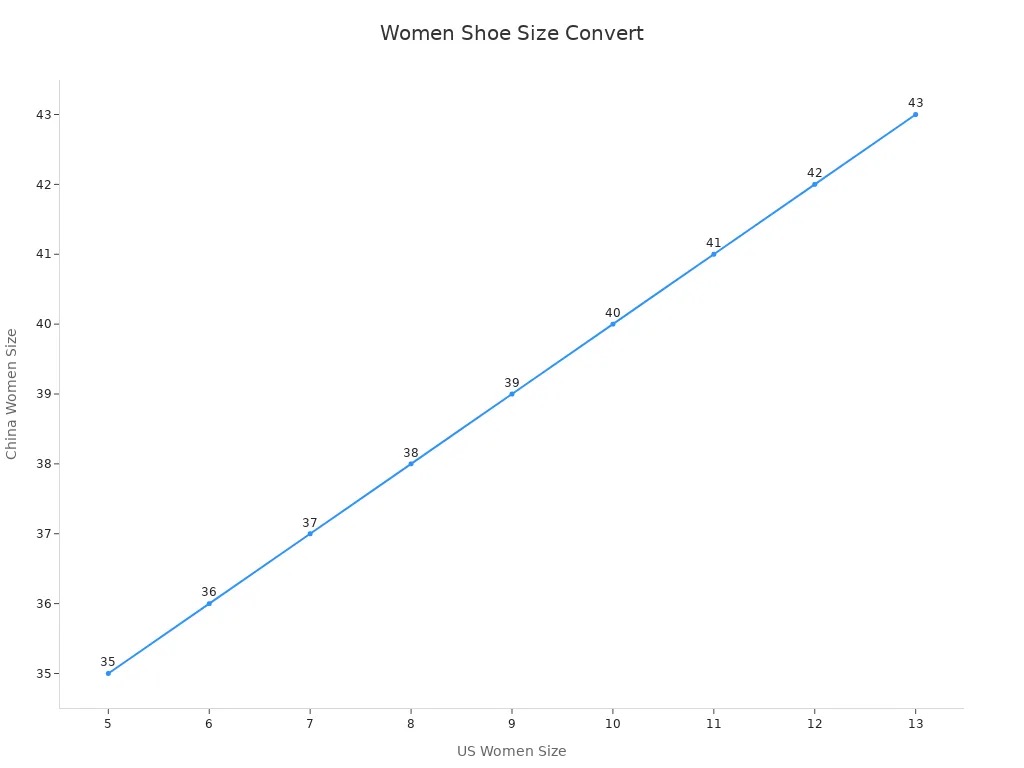
Chinese to US Shoe Size Conversion for Children
Shopping for kids’ shoes can be tricky because their feet grow so fast. Chinese sizes for children are based on centimeters, while US sizes use a separate scale. Here’s a size conversion table to help you out:
US Kids Shoe Size | Chinese Kids Shoe Size |
|---|---|
1.0 | 32 |
1.5 | 33 |
2.0 | 33.5 |
2.5 | 34 |
3.0 | 35 |
3.5 | 36 |
4.0 | 36.5 |
4.5 | 37 |
5.0 | 38 |
5.5 | 39 |
6.0 | 39.5 |
For instance, if your child wears a US size 3, you’ll need a Chinese size 35.
Pro Tip: Kids’ feet grow quickly, so leave a little room for growth when choosing their shoe size. Shoes that are too tight can cause discomfort and foot problems.
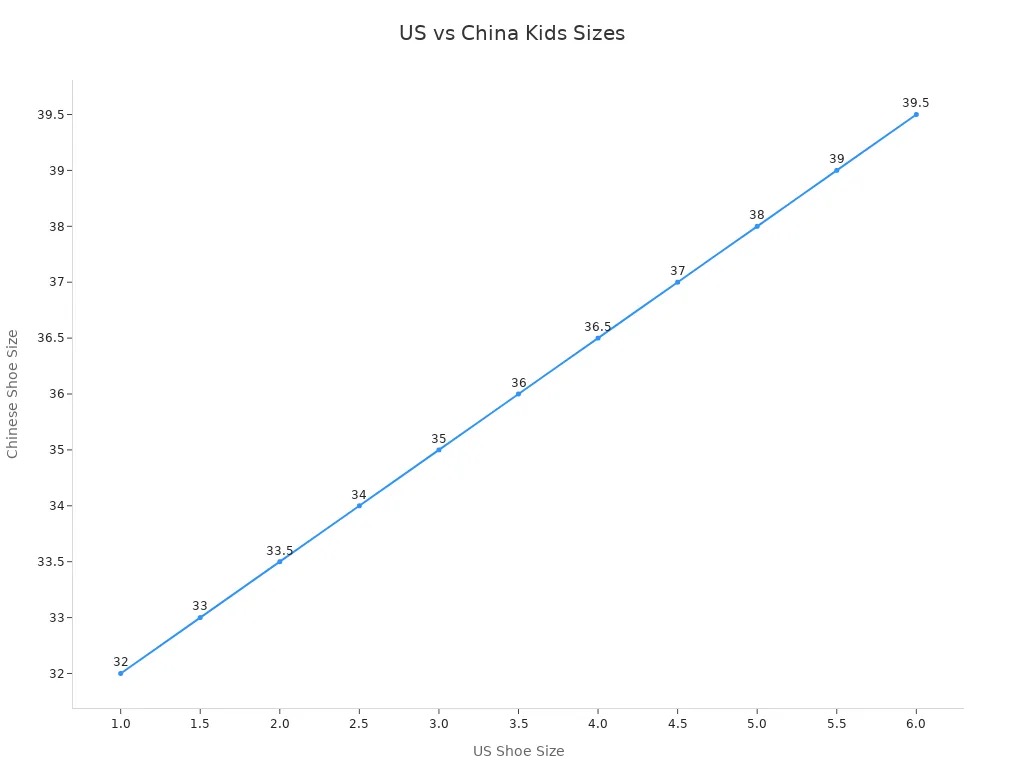
Reliable size conversion tables like these make it easier to shop for shoes online. They help you avoid the hassle of returns and exchanges by ensuring a proper fit.
Chinese to US Shoe Size Conversion for Babies
Shopping for baby shoes can feel overwhelming, especially when you’re trying to figure out the right size. Babies grow so quickly, and their tiny feet need shoes that fit just right. If you’re buying shoes from China, understanding the size conversion between Chinese and US systems is essential. Let’s break it down to make things easier for you.
Chinese baby shoe sizes are based on foot length in millimeters, while US sizes use a numerical scale. This difference can make conversions tricky, but a simple chart can help you find the perfect fit. Here’s a handy table to guide you:
US Baby Size | China Baby Size | Approximate Foot Length (mm) |
|---|---|---|
0 | 15 | 80 |
1 | 16 | 85 |
2 | 17 | 90 |
3 | 18 | 95 |
4 | 19 | 100 |
5 | 20 | 105 |
6 | 21 | 110 |
7 | 22 | 115 |
8 | 23 | 120 |
9 | 24 | 125 |
For example, if your baby’s foot measures 95 mm, you’ll need a Chinese size 18, which corresponds to a US size 3. Measuring your baby’s foot accurately is the first step to ensuring a comfortable fit.
Tip: Measure your baby’s feet at the end of the day. Feet tend to swell slightly as the day goes on, so this ensures the shoes won’t feel too tight.
To visualize the relationship between Chinese and US baby shoe sizes, check out this chart:
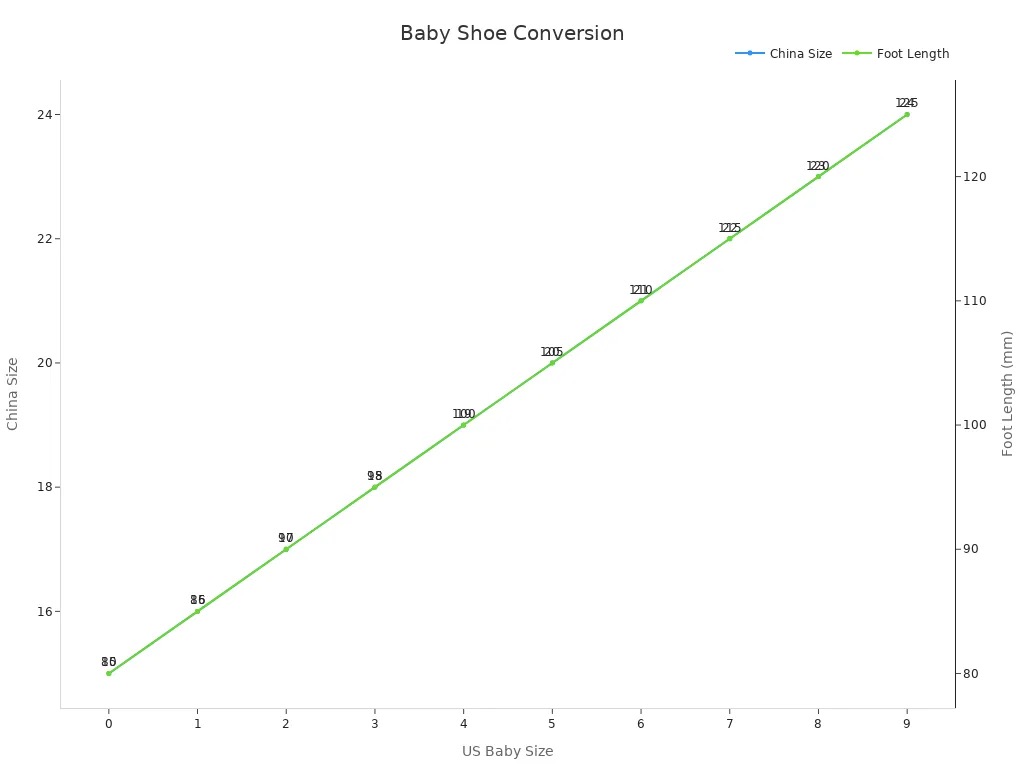
When shopping for baby shoes, remember that comfort is key. Shoes that are too tight can restrict growth, while shoes that are too loose might cause tripping. Always leave a little room for your baby’s toes to wiggle. If you’re unsure, it’s better to go slightly bigger and use socks to fill the extra space.
By using a reliable size conversion chart, you can shop confidently and avoid the hassle of returns. Whether you’re buying shoes for a newborn or a toddler, understanding these measurements will save you time and ensure your baby’s feet stay happy and healthy.
How to Measure Your Feet for the Right Shoe Size
Getting the right shoe size starts with measuring your feet correctly. Proper measurements are the key to finding shoes that fit well. Follow these steps to make sure you get it right every time.
Easy Steps to Measure Your Feet
What You’ll Need
Before starting, gather these simple items:
A ruler or tape measure to check your foot size.
Paper and a pencil to trace your foot shape.
A flat, hard surface like a wooden floor for accuracy.
Optional: A foot scanner for the most exact results.
These tools help you measure your feet easily at home.
How to Measure Foot Length and Width
Here’s how to measure your feet step by step:
Put the paper on a flat, hard floor. Avoid soft surfaces like carpets.
Stand on the paper with your full weight to spread your foot.
Trace around your foot with the pencil, holding it straight for accuracy.
Use the ruler to measure from your heel to your longest toe.
Measure the widest part of your foot for width.
Repeat these steps for your other foot. Feet can be different sizes, so measure both.
Tip: Write down your measurements in both inches and centimeters. This makes it easier to use size charts for shoe conversions.
Helpful Tips for Measuring Feet
Best Time to Measure
Feet swell during the day. Measure them in the evening when they’re largest. This prevents buying shoes that feel tight later.
Include Socks or Insoles
If you’ll wear socks or insoles with your shoes, measure your feet while wearing them. This ensures a comfortable fit with the extra layers.
Mistakes to Avoid When Measuring Feet
Avoid these common errors to get accurate results:
Mistake | Why It’s a Problem |
|---|---|
Measuring on soft surfaces | Soft floors can change your foot shape and give wrong measurements. |
Only measuring one foot | One foot is often bigger. Always use the larger foot’s size for better comfort. |
Skipping the width measurement | Width matters as much as length for a good fit. |
Not wearing socks or insoles | Shoes may feel tight if you forget to include socks or insoles during measuring. |
By avoiding these mistakes, you’ll get better measurements and have an easier time finding the right shoes.
Pro Tip: Measure your feet every few months. Feet can change over time due to age, weight, or other factors. Regular updates ensure your shoes always fit perfectly.
Taking the time to measure your feet properly helps you find shoes that fit well and feel great. Whether you’re buying sneakers, dress shoes, or sandals, accurate measurements save you from discomfort and returns.
Addressing Challenges in Chinese Shoe Sizes
Dealing with Brand-Specific Size Variations
Why shoe size conversion varies by brand
Have you noticed shoes from different brands fit differently? Even if they have the same size label, the fit can change. This happens because brands use their own sizing rules. Some brands design shoes for specific groups, like people with wide feet. Others focus on narrow designs. This makes converting sizes between Chinese and US systems harder.
A study of over 1 million foot scans showed big differences in foot shapes. These differences depend on region and gender. Many shoe designs don’t fit all feet well. This can cause discomfort or even blisters. Correct size conversions are important for comfort and healthy feet.
Why sizes differ by brand:
Brands target different groups, like athletes or casual users.
Some brands focus more on style than comfort.
Manufacturing methods can also create slight size changes.
Using brand-specific size guides for accuracy
Always check the brand’s size guide when buying shoes. These guides match their designs and help you pick the right size. Many brands include details like foot length and width in their charts.
Tip: Read customer reviews if you’re unsure. Shoppers often share if a brand’s shoes run big or small.
Handling In-Between Sizes
Choosing between a larger or smaller size
What if your size is between two options? This happens often with Chinese shoe sizes, which increase by 5mm per size. Picking the right size depends on how you’ll use the shoes.
For daily wear, choose the bigger size. It’s better to have extra room than tight shoes.
For sports shoes, a snug fit works best. This keeps your feet from sliding.
Here’s a quick look at size types:
Type | Description | Example Sizes (China) |
|---|---|---|
Men’s Sizes | Larger sizes made for male feet. | 39-49 |
Women’s Sizes | Narrower sizes designed for female feet. | 35-44 |
Kids’ Sizes | Small sizes for children, often based on age. | 22-32 |
Athletic Sizes | Special sizes for sports shoes. | 38-48 |
Casual Sizes | General sizes for everyday shoes. | 35-50 |
Using insoles or heel grips for adjustments
If your shoes are slightly too big, don’t worry. Insoles and heel grips can help. Insoles add padding and fill extra space inside the shoe. Heel grips stop your foot from slipping out, making the fit more secure.
Pro Tip: Test your shoes with these fixes before wearing them for long hours. This ensures they stay comfortable.
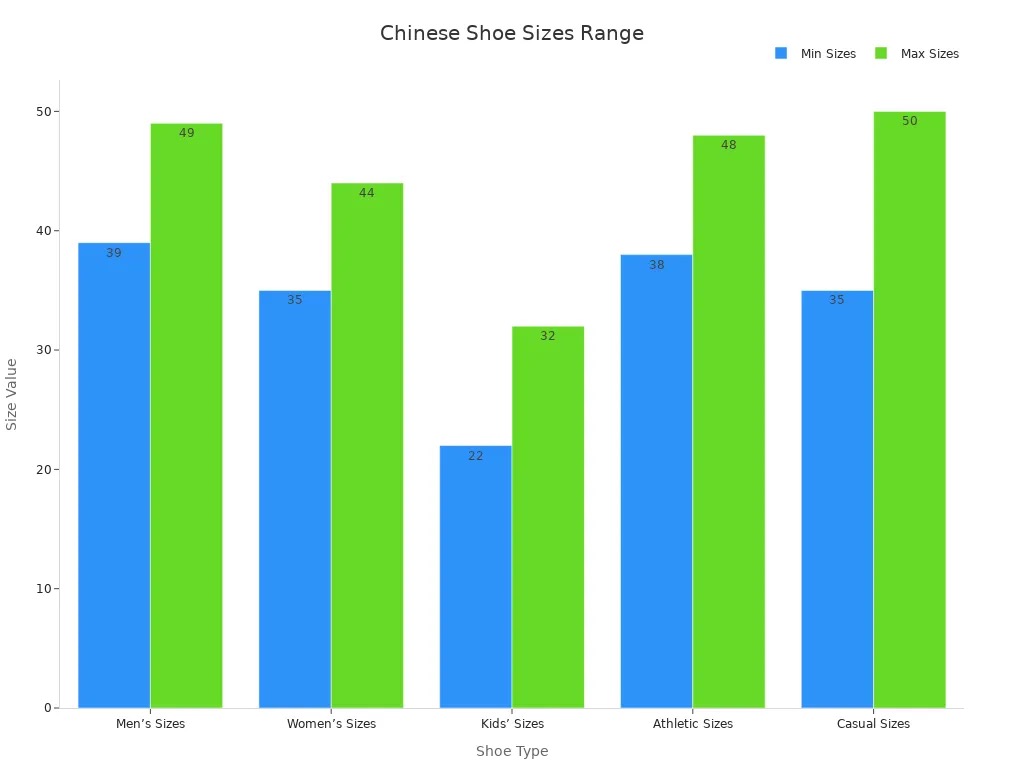
Shopping for Shoes Online
Checking return policies for online purchases
Buying shoes online is easy but risky. Did you know about 30% of online orders are returned? For shoes, 70% of returns happen because of size or fit problems. That’s why checking return policies is so important.
Look for stores that offer free returns or exchanges. Some even provide prepaid return labels to make returns simple.
Note: Keep the box and tags. Many stores need these for returns.
Using customer reviews for sizing insights
Customer reviews are super helpful. People often share how a shoe fits, if it’s true to size, and how comfy it feels. Look for reviews from people with feet similar to yours.
Why reviews help:
They give real-life details that size charts don’t.
You can learn about issues like tight toe areas or stiff materials.
By using size charts, brand guides, and reviews, you can shop online confidently. This lowers the chance of buying the wrong size and needing to return them.
Practical Tips for Ensuring a Proper Fit
Trying Shoes On for Comfort and Fit
Signs of a proper fit
When you try on shoes, pay attention to how they feel. A proper fit means your toes have enough room to wiggle, and your heel stays in place without slipping. The shoe should feel snug but not tight. Walk around to check for any pinching or pressure points. If the shoes feel comfortable right away, they’re likely a good fit.
Did you know? Shoe sizes can vary between brands. A size 8 in one brand might not fit the same as a size 8 in another. Always try shoes on to ensure they fit properly.
Identifying shoes that are too small or too large
Shoes that are too small can cause blisters, bunions, or even long-term foot problems. If your toes feel cramped or the sides of your feet press against the shoe, it’s too small. On the other hand, shoes that are too large can lead to slipping and discomfort. If your foot slides forward or your heel lifts when you walk, the shoes are too big. Always aim for a fit that feels secure and comfortable.
Adjusting for Different Shoe Types
Sneakers vs. formal shoes
Sneakers and formal shoes fit differently. Sneakers often have more padding and flexibility, making them ideal for active use. Formal shoes, however, tend to have a stiffer structure. When buying sneakers, focus on comfort and support. For formal shoes, ensure they fit snugly without being tight, as they may not stretch over time.
Quick Tip: If you’re between sizes, choose the larger size for sneakers. For formal shoes, consider using insoles for a better fit.
Open-toe vs. closed-toe shoes
Open-toe shoes, like sandals, require a different approach. Your toes should not hang over the edge, and the straps should hold your foot securely. Closed-toe shoes, such as boots, need enough room for your toes to move without feeling squished. Always measure your foot length and width to find the right size for each type.
A study involving 111 older adults found that only 6% wore shoes that fit correctly on both feet. Ill-fitting shoes can lead to discomfort and even falls. Always adjust your choice based on the shoe type.
How Yansourcing Helps with Sourcing Clothes and Shoes
Yansourcing’s expertise in sourcing shoes and clothes
Yansourcing simplifies the process of finding the perfect shoes. They provide accurate size charts, helping you measure your feet correctly. Their team connects you with reliable sellers, ensuring high-quality products. Whether you’re looking for sneakers, formal shoes, or sandals, Yansourcing has the expertise to guide you.
Benefits of using Yansourcing for size-specific sourcing
Yansourcing offers several advantages for sourcing shoes tailored to your needs:
They manage shipping and quality checks, so you can shop confidently.
Their detailed size charts make size conversion easy, saving you time and effort.
They work with trusted manufacturers to ensure the shoes meet your expectations.
By choosing Yansourcing, you can avoid the hassle of returns and enjoy a seamless shopping experience.
Conclusion
Knowing Chinese shoe sizes and their US matches helps online shopping. Correct size conversions make sure your shoes fit right and keep feet comfy. Research shows foot sizes differ by region and gender, so accurate charts are important. Shoes with different width choices also make them more comfortable.
Yansourcing makes finding the right shoes and clothes easier. They help you get good-quality items that fit perfectly. Whether you need sneakers or sandals, Yansourcing helps you skip sizing problems and shop with ease.
FAQ
1. What is the easiest way to measure your foot size at home?
Place your foot on a piece of paper, trace it, and measure the length from your heel to your longest toe. Use a ruler for accuracy. This method works well for both Chinese and US size conversions.
Tip: Measure both feet since one foot might be slightly larger.
2. How do Chinese shoe sizes differ from US sizes?
Chinese shoe sizes are based on foot length in centimeters, while US sizes use a numerical system. Chinese sizes increase by 5mm per size, making them consistent. US sizes also include width options, which adds complexity to the conversion process.
3. Can I use a Chinese shoe size chart for all brands?
Not always. Different brands may have slight variations in their sizing. Always check the specific brand’s size guide for accurate conversions. Customer reviews can also help you understand if a brand’s shoes run large or small.
4. What should I do if my size falls between two options?
If your size is between two options, choose the larger size for daily wear. For sports shoes, a snug fit is better. You can also use insoles or heel grips to adjust the fit of slightly larger shoes.
5. Why is it important to measure your feet in the evening?
Feet swell slightly throughout the day. Measuring them in the evening ensures you get the most accurate size. This helps you avoid buying shoes that feel tight later.
6. How can I ensure a proper fit when shopping online?
Use a reliable size chart and measure your feet accurately. Check customer reviews for insights on fit and comfort. Also, review the store’s return policy in case the shoes don’t fit as expected.
7. Are Chinese shoe sizes unisex?
Yes, Chinese shoe sizes are generally unisex. However, US sizes are gender-specific. For example, a Chinese size 39 could correspond to a US men’s size 6.5 or a US women’s size 8.
8. Can I return shoes if they don’t fit?
Most online stores allow returns for size issues. Check the return policy before purchasing. Keep the original packaging and tags intact to make the return process smoother.

